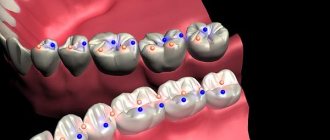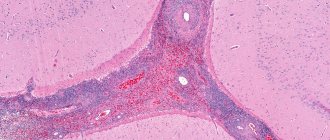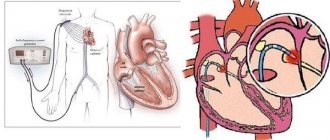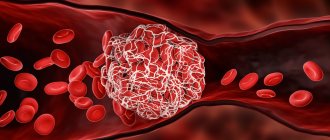Synonyms: Fibrin degradation fragment, D-dimer, Fragment D-dimer, Fibrin degradation fragment.
Scientific editor: M. Merkusheva, PSPbSMU named after. acad. Pavlova, medical practice.
D-dimer is a protein fraction, the result of fibrin breakdown during the process of dissolving blood clots (fibrinolysis). D-dimer is considered a fairly informative indicator of thrombus formation, since the mechanism of its production starts simultaneously with the process of thrombus formation.
The D-dimer test allows you to evaluate two factors in combination: coagulation (blood clotting) and fibrinolysis (dissolution of clots). The marker makes it possible to promptly detect an imbalance between them in the case of diseases of the circulatory system (varicose veins, thrombophilia, pulmonary embolism, etc.).
General information
Violation of the integrity of blood vessels is usually accompanied by bleeding, which requires fibrin to stop. This protein is involved in the formation of blood clots (thrombi), and they, in turn, plug bleeding gaps.
An increase in the concentration of fibrin in the blood provokes the formation of more blood clots than necessary. This condition is fraught with the development of thrombosis of veins and arteries. To regulate the process, the body produces a special enzyme, plasmin, which dissolves excess fibrin. The result of this chemical reaction is D-dimer. Its level should be directly proportional to the intensity of fibrinolysis.
The following factors can affect the formation of D-dimer:
- volume of dissolved thrombus;
- the period from the onset of the disease to the moment of taking anticoagulants (D-dimer begins to decrease during treatment);
- prescribing thrombolytic therapy (D-dimer increases).
In a healthy person, the concentration of D-dimer is stable (not higher than 243 ng/ml). Increased values may reflect the onset of coagulation. Also, pathologies of this process are possible with DIC syndrome, pulmonary embolism, venous thrombosis, heart disease, massive burns, serious surgical interventions, etc.
D-dimer increases in pregnant women, elderly people, cancer patients, as well as in bedridden patients (with prolonged immobilization), as well as in patients with high levels of rheumatoid factor in rheumatoid arthritis.
Although D-dimer is an important marker of thrombosis and related conditions, it has only recently become part of a comprehensive blood test - coagulogram. And since this test is more than 98% indicative, D-dimer is often determined in the emergency department to exclude thromboembolism (acute blockage of blood vessels by blood clots) in “severe” patients.
In the process of interpreting the study results, not only the concentration of D-dimer in the blood is analyzed, but also its dynamics, which makes it possible to evaluate the effectiveness of the therapy, as well as predict the risk of developing acute complications of thrombosis.
Indications for analysis
The D-dimer test is carried out as part of a coagulogram, which involves drawing blood from a vein.
The main indications for analysis are the following:
- Age over 80 years;
- General diagnosis of thrombotic conditions;
- Diagnosis of related diseases: DIC syndrome;
- deep vein thrombosis;
- pulmonary thromboembolism;
- cerebrovascular accidents (stroke);
- heart attack, etc.;
- threat of miscarriage;
The following symptoms may indicate the need for research:
Symptoms of deep vein thrombosis:
- swelling, pain and numbness in the area of one or two lower extremities, increasing with physical activity;
- pallor or cyanosis of the skin in the area of thrombosis.
Symptoms of pulmonary embolism
- sudden shortness of breath,
- difficulty breathing,
- hemoptysis,
- chest compression;
- sharp pain in the chest.
During pregnancy:
- headaches, toxicosis, weakness, swelling, high blood pressure and protein in the urine in pregnant women;
And other symptoms:
- tachycardia, arrhythmia and pain in the heart;
- bleeding of unknown etiology;
- severe pain in muscles and abdomen;
- urinary disorders (reduced urination), etc.
- cyanosis of the skin.
Treatment tactics
An increased dimer concentration indicates the need for treatment. Otherwise, severe pregnancy complications are possible.
First of all, the doctor prescribes drugs that normalize the rheological properties of the blood and prevent the formation of blood clots. For this purpose, pregnant women are recommended to administer intravenous solutions that improve the functioning of the microvasculature and indirect anticoagulants. Treatment is carried out on an outpatient basis, less often in a hospital setting. It is very important to monitor D-dimer and blood clotting over time.
If the dimer is reduced, the woman is prescribed coagulants, vitamin K preparations, and in severe cases, platelet transfusions.
Before prescribing treatment, the doctor should understand that the D-dimer blood test is a relatively new test that often gives false positive results. Patients of the Altravita reproductive medicine clinic are recommended to donate blood at a local laboratory. It is equipped according to the latest international requirements, and the medical staff has extensive experience. This allows you to reduce the risk of diagnostic error to a minimum.
D-dimer standards
Standard reference values:
The common unit of measurement is µg FEU/ml
- Normally, D-dimer should not exceed 0.55 μg FEU/ml.
Reference values during pregnancy:
| Week of pregnancy | Reference values |
| Until 13th | 0 - 0.55 µg FEU/ml |
| 13-21st | 0.2 - 1.4 µg FEU/ml |
| 21st-29th | 0.3 - 1.7 µg FEU/ml |
| 29-35th | 0.3 - 3 µg FEU/ml |
| More than 35 | 0.4 - 3.1 µg FEU/ml |
The standards of the Invitro laboratory, Invitro values, are somewhat different from the standard ones, since the more modern equipment of this laboratory allows measurements to be taken with greater accuracy.
The unit of measurement in Invitro is ng/ml.
- The normal D-dimer level is less than 243 ng/ml.
Threshold values for pregnant women in Invitro:
| Trimester | D -dimer, ng/ml |
| 1st | up to 286 |
| 2nd | up to 457 |
| 3rd | up to 644 |
Note:
if the analysis shows a sharp increase in the level of D-dimer, then it is necessary to exclude a significant number of blood clots in the bloodstream.
This condition occurs with venous thromboembolism (blockage of veins by blood clots), DIC syndrome (thrombosis in small vessels). However, it is important to understand that the D-dimer test cannot determine the location of blood clots, their size or number. Important! The interpretation of the results is always carried out comprehensively. It is impossible to make an accurate diagnosis based on only one analysis.
Blood donation
Externally, donating blood is no different from a regular intravenous injection. The prepared patient is placed on a couch or asked to sit in a special chair. Then the woman needs to expose her arm above the elbow. A nurse applies a venous tourniquet just above the elbow, and the woman is asked to clench and unclench her fist several times. The injection site is treated with alcohol twice, after which an injection is given and the required amount of blood is collected. At this point, the patient may experience minor discomfort. After completing the set, a cotton ball moistened with alcohol is applied to the injection site and asked to hold the arm in a bent position. The resulting material is sent to the laboratory for further research.
Increasing values
- The presence of arterial and venous blood clots;
- Acute inflammatory or infectious process;
- Sepsis (severe infection of the body);
- Liver and kidney diseases;
- Oncological processes;
- Extensive hematomas (for example, as a result of a fall, compression, etc.).
Physiological increase in D-dimer concentration:
- normal pregnancy (moderate increase from the 1st trimester);
- pathological pregnancy (critical level of indicator);
- old age (from 80 years);
- recent surgery;
- thrombolytic treatment.
Determination of D-dimer in pregnant women
A coagulogram is a mandatory screening test during pregnancy (performed every trimester). It measures D-dimer, the level of which varies depending on the stage of pregnancy and the general health of the woman. If the concentration of a component in the blood increases, the doctor prescribes a control ultrasound and unscheduled blood tests (coagulogram) to track changes in dynamics.
On a note:
in pregnant women, D-dimer begins to increase in the early stages and by the end of the 3rd trimester it can exceed the norm by 3-4 times. In the case of complicated pregnancy (preeclampsia, gestosis, diabetes, kidney damage, etc.), its concentration reaches critical values.
High D-dimer in pregnant women may indicate:
- diabetes mellitus (glucose metabolism disorder);
- gestosis (late toxicosis);
- eclampsia and preeclampsia;
- phlebeurysm;
- liver and kidney pathologies;
- development of an acute infectious process.
All these conditions are dangerous for the health of the expectant mother and child, as they can cause serious complications: threat of miscarriage, premature birth, placental abruption, etc. If the D-dimer during pregnancy exceeds the maximum permissible norms for a long time, the woman is hospitalized in a hospital to prevent the development of thrombosis.
Causes of increased D-dimer
One of the reasons for the increase in the level of D-dimer and the activation of the coagulation system is the preparation of the body for childbirth, which in any case is accompanied by blood loss of varying degrees of intensity. Therefore, the maximum level of D-dimer will be observed precisely in late pregnancy. In general, its level increases approximately threefold compared to non-pregnant healthy women.
An increase in D-dimer is often observed along with other signs of late toxicosis of pregnancy (preeclampsia). These include:
- persistent increase in blood pressure, which is difficult to treat with antihypertensive drugs;
- the appearance of protein in the urine;
- swelling of the upper and lower extremities, face and neck.
Reference! Preeclampsia is a condition that is dangerous due to its complications - eclampsia and preeclampsia. These pathologies are characterized by cerebral circulation disorders and, if left untreated, pose a serious threat to the life of the mother and child.
If D-dimer is slightly elevated
A slight excess of D-dimer levels can be observed in the following cases:
- during multiple pregnancy;
- after operations (even if they were performed a year or two before the study);
- for influenza, acute respiratory infections and acute respiratory viral infections;
- for injuries and burns.
In these cases, D-dimer increases temporarily, its level returns to normal values after stabilization.
Pathological causes of increased D-dimer
In some cases, an increase in D-dimer levels can be observed in certain chronic diseases, often asymptomatic. These include:
- regular and gestational diabetes mellitus (the latter is typical only during pregnancy and goes away after childbirth);
- liver and gallbladder diseases;
- various kidney diseases that impair their function;
- cardiovascular pathologies (including those of inflammatory origin - myocarditis, pericarditis);
- constant exposure to allergens.
Important! An increase in D-dimer can sometimes be one of the first signs of incipient placental abruption. Symptoms: nagging pain in the abdominal area of varying degrees of intensity, discharge mixed with blood, nausea and dizziness. The appearance of these signs requires immediate medical attention!
Preparing for analysis
- It is preferable to donate blood for D-dimer in the morning on an empty stomach (the last meal - 8-10 hours before the test); before the test you can drink still water.
- It is also permissible to donate blood during the day, but not earlier than 4 hours after a light meal.
- The day before taking blood, it is necessary to exclude increased psycho-emotional and physical stress, and alcohol intake.
- Do not smoke 30 minutes before the test, incl. e-Sigs.
Sources:
- Data from the independent laboratory Invitro and Helix
- Jeffrey I. Weitz; James C. Fredenburgh; John W. Eikelboom "A Test in Context: D-dimer" Journal of the American College of Cardiology 2017;70(19):2411-2420.
Read more about blood clotting indicators
- Coagulogram: main indicators
- Fibrinogen in the blood
- APTT
- Prothrombin
- Thrombin time
- D-dimer
- Lupus anticoagulant
- Antithrombin III
- Plasminogen
- Protein C
- Protein S free
- Coagulogram during pregnancy








